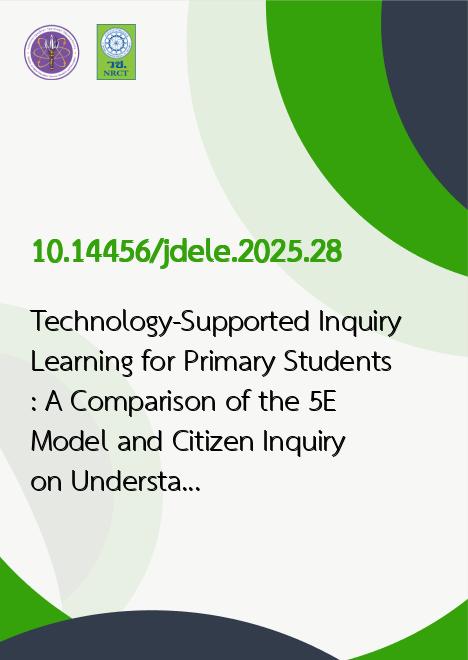
|
Technology-Supported Inquiry Learning for Primary Students: A Comparison of the 5E Model and Citizen Inquiry on Understanding and Attitudes |
|---|---|
| รหัสดีโอไอ | |
| Creator | Pawat Chaipidech |
| Title | Technology-Supported Inquiry Learning for Primary Students: A Comparison of the 5E Model and Citizen Inquiry on Understanding and Attitudes |
| Contributor | Pichaya Thongkhong, Napaporn Sriwarom, Pawat Chaipidech |
| Publisher | Digital Education and Learning Engineering Association |
| Publication Year | 2568 |
| Journal Title | Journal of Digital Education and Learning Engineering |
| Journal Vol. | 1 |
| Journal No. | 3 |
| Page no. | 107–123 |
| Keyword | Inquiry-based learning, 5E model, Citizen Inquiry technology, integration primary education |
| URL Website | https://so18.tci-thaijo.org/index.php/delethailand |
| Website title | Journal of Digital Education and Learning Engineering Association |
| ISSN | 3088-1552 |
| Abstract | Inquiry-based pedagogy supported by digital tools has been increasingly recognized as a promising approach to strengthen students’ conceptual understanding and engagement in science learning. However, limited research has examined how different inquiry frameworks function in technology-rich primary classrooms. This study aimed to compare students’ understanding of water resources and conservation concepts and to examine their attitudes toward science learning with technology when taught through either the 5E model or Citizen Inquiry. A quasi-experimental design was conducted with 70 Grade 5th students across two groups. The findings indicated that both instructional approaches improved the students’ conceptual understanding. Moreover, those who learned with the citizen Inquiry with technology demonstrated significantly higher post-test scores than those who learned with the 5E model with technology. In contrast, no significant differences were found in students’ attitudes across five measured dimensions, although Citizen Inquiry showed a slight, non-significant advantage in affective engagement. These results suggested that the two approaches offer distinct strengths, and that hybrid instructional designs combining structured scaffolding with authentic participation may provide a balanced pathway for supporting both conceptual development and meaningful engagement in science classrooms. |